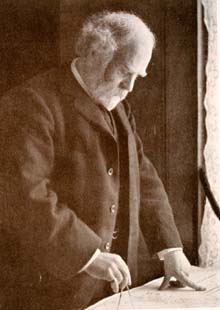John Murray (oceanographer)
| John Murray | |
|---|---|

Sir John Murray, 1902
|
|
| Born |
3 March 1841 Cobourg, Canada West |
| Died | 16 March 1914 (aged 73) Kirkliston, Midlothian, Scotland |
| Nationality | British |
| Fields | oceanography limnology |
| Institutions | Challenger Expedition Commission (1872) Director of the Challenger Expedition Commission (1882) Established marine laboratories at Granton and Millport |
| Alma mater | Edinburgh University |
| Notable awards |
Makdougall-Brisbane Prize (1884–86) Neill Prize (1877–80) Cullum Geographical Medal (1899) Clarke Medal (1900) Vega Medal (1912) |
| Author abbrev. (botany) | J.Murray |
| Spouse | Isabel Henderson (1889) |
| Children | 3 daughters, 2 sons |
| Notes | |
|
President of the Royal Scottish Geographical Society (1898–1904)
President of the Scottish Natural History Society Member of the Scottish Meteorological Society |
|
Sir John Murray KCB FRS FRSE FRSGS (3 March 1841 – 16 March 1914) was a pioneering British oceanographer, marine biologist and limnologist. He is considered to be the father of modern oceanography.
Murray was born at Cobourg, Canada West on 3 March 1841. He was the second son of Elizabeth Macfarlane and Robert Murray, an accountant. His parents had emigrated from Scotland to Ontario in about 1834. He went to school in London, Ontario and later to Cobourg College. In 1858, at the age of seventeen he returned to Scotland to live with his grandfather, John Macfarlane, and continue his education at Stirling High School. In 1864 he enrolled at University of Edinburgh to study medicine however he did not complete his studies and did not graduate.
In 1868 he joined the whaling ship, Jan Mayen, as ship's surgeon and visited Spitsbergen and Jan Mayen Island. During the seven-month trip he collected marine specimens and recorded ocean currents, ice movements and the weather.
On his return to Edinburgh he re-entered the University to complete his studies (1868–72) in geology under Sir Archibald Geikie.
In 1872 Murray assisted in preparing scientific apparatus for the Challenger Expedition under the direction of the expedition's chief scientist, Charles Wyville Thomson. When a position on the expedition became available Murray joined the crew as a naturalist. During the four-year voyage he assisted in the research of the oceans including collecting marine samples, making and noting observations and making improvements to marine instrumentation. After the expedition Murray was appointed Chief Assistant at the Challenger offices in Edinburgh where he managed and organised the collection. After Thompson's death in 1882 he became Director of the office and published in 1896 The Report on the Scientific Results of the Voyage of HMS Challenger, a work of more than 50 volumes of reports.
...
Wikipedia
